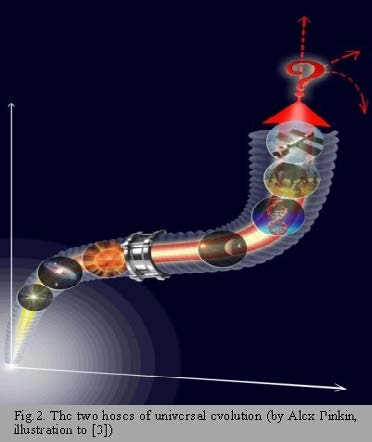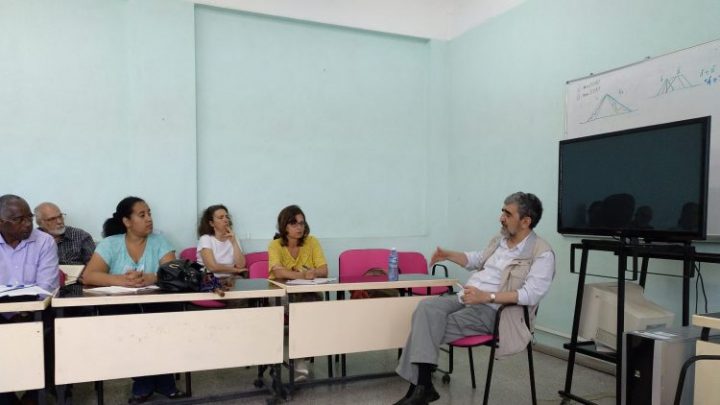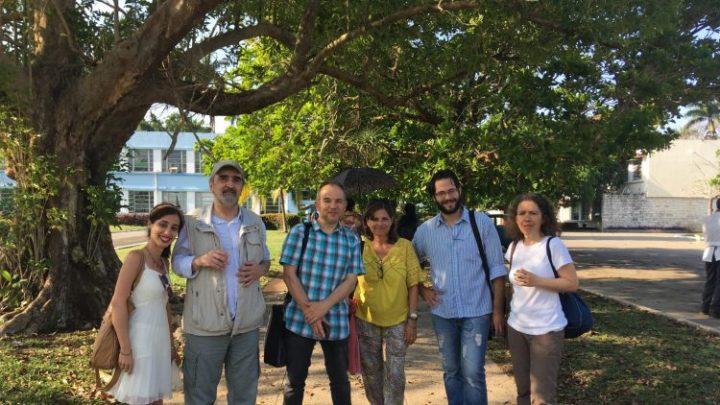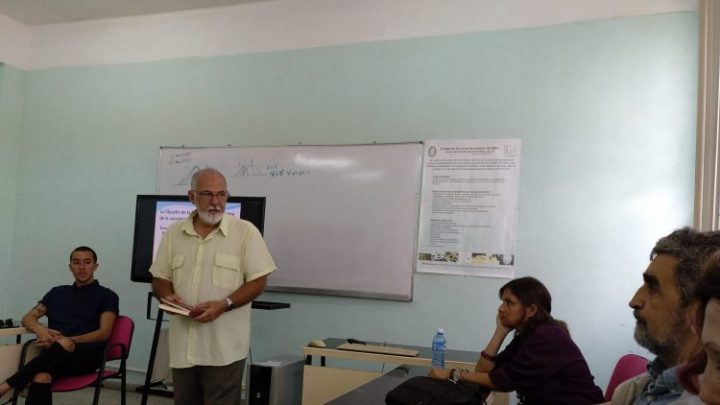Summary of the first lecture by Akop Nazaretian, in the postgraduate course, “Theoretical Approaches to History”, organized by the Department of Philosophy of the Central University Marta Abreu de las Villas and with the collaboration of the Centre for Humanist Studies Toltecáyotl and the International News Agency Pressenza.
The postgraduate course began with the words of Professor Rafael Pla León and the lecture by María Teresa Vila Bormey “The problem of historical awareness and the philosophy of history”. (Video in Spanish)
The global scenarios of the 21st century in the light of mega-history
Akop Nazaretian, April 24, 2018.
Yesterday, our colleague, Maria Teresa, spoke to us about the conceptions of Hegel’s history and Marxism. Next week, on May 5, we celebrate the bicentennial of Karl Marx. That’s why I want to start with a date. Marx and Engels wrote in the first half of the 19th century “we know only one science: the science of history, this history is divided into the H of nature and the H of men”. So they anticipated many steps of science, but then they did not even imagine that the history of nature would include much more than the history of the Earth…. The materialistic scientists of the time imagined that evolution encompasses nothing more than the Earth and the Solar System. The Universe had no beginning, no end and was therefore anti-historical. This was thought of for several more decades.
I will give another quote: a well-known scientist, Michio Kaku, said: “The generations living today are the most significant in all human history and prehistory. Because they will be the ones who will determine whether humanity continues towards its new evolutionary goal.
Possibly our present wives are giving birth to potential gods, who will have access to some forms of immortality and cosmic dominance or will be a generation of suicides who will begin the irreversible fall of the anthroposphere.
In reference to Universal History, as we now understand it, during the 18th and 19th centuries three models of history were established in Europe; a new one, that of progress and development, either geo-centric or linear, ranging from the worst to the best. That was the vision in Central Europe, the rest: Eastern Europe, China, Japan, America, were considered peripheral.
Another more traditional model considered that the world is on a downward path (since the Golden Age…). This was supported by thermodynamics (the growth of entropy over time).
Some physicists said: both models cannot be right. A joke was made then about thermodynamics compared to an old aunt, who you may not like but always happens to be right.
Then they began to consider that history is not common to all civilizations.
At that time, at the end of the 18th century, the concept of History was shaped in the present sense; before, it was used in plural: “stories”, as accounts of separate events.
At the beginning of the 20th century, Europeans entered a wave of hope. Everything was going to be better: morale, economy, etc. It was written in brilliant books and it was said that there could never be wars again! These were reserved for Africa, Asia or America; but Europe would be free of wars forever. History and wars were things of the past. But the two world wars in Europe brought down the mood of Europeans. They had to admit they were wrong. Toynbee wrote that his 16-volume book on history had to be finished only because he had promised to do so.
In the 1980s, the concept of global history appeared. Human history cannot be separated from the evolutionary processes of nature, since the history of the Earth itself is part of the history of the Universe. For some 14 billion years, increasingly complex structures have developed. From the Big Bang – which is the horizon of our retrospective vision – the transformations in the universe follow certain vectors…. In the 70s and 80s the cosmological arrow of time is discovered. Until then no one had been able to contradict the thermodynamic arrow of time.
Today astrophysicists present two arrows: thermodynamics and cosmology. These show us the vector of development from the most chaotic, casual and simple conditions to the most complex conditions. Among the fascinating effects of that process are us; our brain and our spirit.

This is how the history of humankind and universal history were differentiated

In the first billion years of evolution, since the Big Bang, the speed of processes has slowed down. This was considered the first stage of evolution. Then, at -10 billion years old, the entrails of the first generation stars synthesized the heavy elements and this produced a second wave of accelerations from the explosion of supernovae. At that time, a new self-organising mechanism was created, different from the previous processes. (Because the heavy elements need free energy from the outside). Development towards organic matter began and a new acceleration began. As a result, the Solar System and the Earth appeared.
If you look at the Earth, the following picture appears:

There is every reason to claim that life did not appear on Earth originally. The idea that the first living organisms are older than the oceans is widely accepted. These are organisms that can travel in the cosmos in extreme conditions (without water and subjected to strong radiation…).
In the first phase of evolution the meteoric activity was very intensive. When this activity was moderated the organisms were able to begin their evolutionary process.
Several scientists observed that evolution had a regular rhythm…. By comparing precisely the periods of existence free of global crises, researchers from different countries, independently and almost simultaneously, made a surprising discovery. These are the Australian Graeme Snooks, the Russian Alexander Panov and the American Raymond Kurzweil, who, finding a strictly logarithmic sequence in the accelerated change of phases of social and pre-social evolution -without yet suspecting the work of their colleagues- tried to continue retrospectively the obtained curve.
All three found the same fact: after 4 billion years, the acceleration continues, precisely following a logarithmic formula. The interval between global catastrophes followed by phase transitions is reduced by one third. Evolution followed an extremely regular schedule until the appearance of homo sapiens, this crazy factor with its own will.
On Earth there were fluctuations in the climate, the level of the oceans changed, the continents shifted, volcanoes exploded, celestial bodies fell, magnetic poles moved; all of which was joined by the free will of extravagant humanity. However, the irreversible phase transitions of global evolution followed one another chronometrically. This surprising fact constitutes the most complete demonstration that the revolutionary leaps in the history of nature and society were provoked, not by accidental cataclysms, but by endo-exogenous crises that became more frequent as the antientropic activity intensified.
This is explained in the models we call synergetic, the Americans called it chaos theory, in Chile autopoesis, the French call it thermodynamics of imbalance.
In the 21st century we can build a model of the past thanks to the fact that in all the critical stages of the earth’s evolution strange vertical attractors were made.
Probably, some of these crucial episodes could have been solved according to a different scenario and events could have taken place in the direction of a simple or horizontal attractor. The first is the case of a degradation of the biosphere (or anthroposphere); the second is that of a prolonged suspension of evolution with stabilisation, according to the ecology-mathematical model of “wolves – hares”.
Around the middle of the 21st century, what is called in mathematics the point of singularity appears. It is the point in hyperbole where the value of the functions tends to infinity, the curve becomes a straight line.








In America, NASA has formed the University of Singularity, in Moscow we have formed, in preparation for the future, the Centre for Mega History and Systemic Forecasting.
The objective reality is that mathematically we come to a singularity. But what’s behind that? That’s what we study. Thus, we come to a fork in the road. The last billion years of evolution must be resolved in the coming decades.
Behind the singularity may begin the descending branch of history. The attractor indicates that the Earth will once again be a normal body like the Moon or Mars, deprived of life (spiritual, philosophical, etc.). This will not take millions of years, it may be a matter of days or millennia, because it will be the result of human activity. Several philosophers speculated on this possibility, but imagined that it would happen tens of millions of years from now, as a natural process.
The father of nanotechnology, Eric Drexler, warned that aggressive nanobacteria could soon become available. Atomic bombs are old weapons that no longer serve to maintain balance, new weapons are more modern, cheaper and perhaps more accessible. So one of the scenarios is the possibility of eliminating the entire population of a given ethnic group.
Another attractor, the horizontal, indicates that humanity, having achieved enough stability, loses interest in the external life and escapes towards virtual life (in the virtual world all vital activity is carried out).
The other possibility is that the planetary cycle of evolution may be transformed into a great cosmic cycle accompanied by profound transformations of the human being (an intellectual shock wave out of the “bedroom planet”).
20th century physicists almost unanimously wrote that the mind, the intellect, the spiritual culture and the whole society are epiphenomena of the development of physical structures and nothing else and cannot play any role in the life of the universe; they are a secondary phenomenon.
In the 20th century only a few Soviet physicists, influenced by so-called Russian cosmism (cosmos philosophy), dared to write that, perhaps, man through intellect could hypothetically change structures of the universe.
Steven Weinberg (winner of the 1979 Nobel Prize in Physics) wrote: “The effort to understand the universe is one of the few things that elevates human life above the level of farce and imprints some of the elevation of tragedy on it. Our existence is a farce. And the materialistic philosophers wrote the same thing: that, from the cosmic point of view, what we do is a farce. This gives us a nuance of a great tragedy.
Others also spoke in this sense of the growth of entropy and cosmic garbage (assimilating it to the human process).
These were exotic hypotheses of the last century, but from the 21st century onwards, the intellectual environment in physics began to change radically. Today it is possible to read in the specialised press that consciousness is a cosmological essence, that our presence in the Universe is not accidental, that consciousness is a more fundamental reality than atoms and that the future of the Universe fundamentally depends on our human knowledge in the broadest sense.
It is not Russians, it is not philosophers, it is not psychologists, who say this. If psychologists had written it… But these are professional astrophysicist who say that when the intellect takes power from the physical processes of the Universe it then forms new Universes by means of an explosion directed at a black hole. They also talk about a Drawinian selection in the Universes (it sounds a bit ridiculous, but it is written seriously by world-renowned scientists). The artificially formed Universes would discard the naturally formed ones…… (1)
Psychology, in particular Gestalt, showed that the tuning fork of cosmic energy management has no limits, that any constant exists as a standard within a certain model. You can always find a metamodel even if the shapes vary. According to this the Cosmos should be filled with powerful civilizations. But since the beginning of the 1950s, the paradox has arisen of the great Italian physicist, Enrico Fermi, which is comfortably stated: where are they?
According to all current cosmological theories it is observed that in some places life must have been formed much earlier than on Earth. Then, in the last few years, astronomical technology has discovered two new planets every week. Some planets very similar to Earth have been registered in recent years, but there is no evidence of any intellectual activity outside Earth, so Fermi’s paradox is becoming more and more acute.
In the face of this, there are several picturesque theories, such as that extraterrestrials hide waiting for humanity to overcome the stage of aggressiveness, for example. More recently there is talk of silence of the Cosmos: possibly the Cosmos is silent because the metagalaxy has not yet produced an intellect commensurate with its universal purpose.
In evolutionary history, in each case events could have happened differently. We have the example of the Cuban missile crisis. It’s a miracle a nuclear war didn’t break out at the time. At that time there was no particular fear of nuclear war. In China, for example, it was even said that survivors of nuclear war would live better lives.
The atmosphere of that time was no future, hippies for example spoke of freedom now, living in the moment, love now. The 20th century was practically over under these conditions.
According to the implementation principle, everything that can happen happens. Then there should be other planets where there were other scenarios.
In hyperbole, when we analyze each transition, we clearly see that the opposite could have happened: degradation. We live on this planet thanks to the fact that in each case the strange vertical attractor was realised.
There must be other planets where a crisis like the Caribbean or the Palaeolithic crisis would have been definitive. We can assume that very few reach their evolutionary goal and that many remain as the debris of evolution.
If we accept this, we can think that the current situation corresponds to a decisive stage in the evolutionary process.
One of the destructive scenarios at this time is as follows:
We are now observing and studying in detail the situation in North America, Latin America, the Middle East, Russia… observing that there is a process of religious rebirth, a rebirth of nationalist, patriotic socialist fundamentalism… The same idea of national interests, when no one can choose the nation in which they are born… And what is the difference between interest, ambition, profit or a whim? What’s the difference? And these empty phrases are what drive it.
If this process of fundamentalism continues, it may prove irreversible, a fall into the Middle Ages. But the Middle Ages of our time cannot feed 7 billion people. That means memory loss, with the old technologies. Then begins the war of all against all. Besides, all the chemical and atomic weapons that are neglected…. This is how you get to what scientists call the equilibrium sphere. We now live in an area of sustainable imbalance. Life is the sustainable balance.
Then we are going to talk about humanism, about how the future depends on the development of humanism. That is not the whim of some – “good people, humanists” – is the survival imperative of our planet and of the human species.
[Conference video in Spanish]
—
1: Quote from the editor:
Many approaches that seek to bring the latest discoveries in physics and cosmology into line with other areas of human thought are part of the so-called “anthropogenic principle” that emerged in the late 20th century.
In reference to what Nazaretián said in his talk, Michio Kaku explains the following in his book “Physics of the impossible”.
“If we concentrate enough energy at one point, all we would have is a collapse of space-time in a black hole” (…) “It is conceivable that a civilization hundreds of thousands or a million years more advanced than ours would be able to direct such a black hole in the direction of a white one”.










